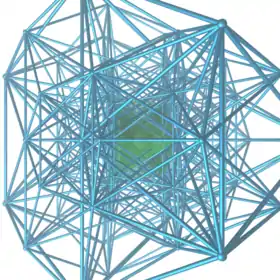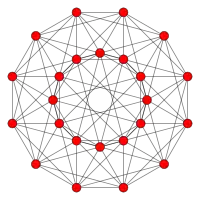16-cell honeycomb
In four-dimensional Euclidean geometry, the 16-cell honeycomb is one of the three regular space-filling tessellations (or honeycombs), represented by Schläfli symbol {3,3,4,3}, and constructed by a 4-dimensional packing of 16-cell facets, three around every face.
| 16-cell honeycomb | |
|---|---|
 Perspective projection: the first layer of adjacent 16-cell facets. | |
| Type | Regular 4-honeycomb Uniform 4-honeycomb |
| Family | Alternated hypercube honeycomb |
| Schläfli symbol | {3,3,4,3} |
| Coxeter diagrams | |
| 4-face type | {3,3,4} |
| Cell type | {3,3} |
| Face type | {3} |
| Edge figure | cube |
| Vertex figure |  24-cell |
| Coxeter group | = [3,3,4,3] |
| Dual | {3,4,3,3} |
| Properties | vertex-transitive, edge-transitive, face-transitive, cell-transitive, 4-face-transitive |
Its dual is the 24-cell honeycomb. Its vertex figure is a 24-cell. The vertex arrangement is called the B4, D4, or F4 lattice.[1][2]
Alternate names
- Hexadecachoric tetracomb/honeycomb
- Demitesseractic tetracomb/honeycomb
Coordinates
Vertices can be placed at all integer coordinates (i,j,k,l), such that the sum of the coordinates is even.
D4 lattice
The vertex arrangement of the 16-cell honeycomb is called the D4 lattice or F4 lattice.[2] The vertices of this lattice are the centers of the 3-spheres in the densest known packing of equal spheres in 4-space;[3] its kissing number is 24, which is also the same as the kissing number in R4, as proved by Oleg Musin in 2003.[4][5]
The related D+
4 lattice (also called D2
4) can be constructed by the union of two D4 lattices, and is identical to the C4 lattice:[6]




 ∪
∪ 



 =
= 





 =
= 








The kissing number for D+
4 is 23 = 8, (2n – 1 for n < 8, 240 for n = 8, and 2n(n – 1) for n > 8).[7]
The related D*
4 lattice (also called D4
4 and C2
4) can be constructed by the union of all four D4 lattices, but it is identical to the D4 lattice: It is also the 4-dimensional body centered cubic, the union of two 4-cube honeycombs in dual positions.[8]




 ∪
∪ 



 ∪
∪ 



 ∪
∪ 



 =
= 



 =
= 



 ∪
∪ 



 .
.
The kissing number of the D*
4 lattice (and D4 lattice) is 24[9] and its Voronoi tessellation is a 24-cell honeycomb, ![]()
![]()
![]()
![]()
![]() , containing all rectified 16-cells (24-cell) Voronoi cells,
, containing all rectified 16-cells (24-cell) Voronoi cells, ![]()
![]()
![]()
![]()
![]()
![]()
![]() or
or ![]()
![]()
![]()
![]()
![]()
![]()
![]() .[10]
.[10]
Symmetry constructions
There are three different symmetry constructions of this tessellation. Each symmetry can be represented by different arrangements of colored 16-cell facets.
| Coxeter group | Schläfli symbol | Coxeter diagram | Vertex figure Symmetry |
Facets/verf |
|---|---|---|---|---|
| = [3,3,4,3] | {3,3,4,3} | [3,4,3], order 1152 | 24: 16-cell | |
| = [31,1,3,4] | = h{4,3,3,4} | [3,3,4], order 384 | 16+8: 16-cell | |
| = [31,1,1,1] | {3,31,1,1} = h{4,3,31,1} | [31,1,1], order 192 | 8+8+8: 16-cell | |
| 2×½ = [[(4,3,3,4,2+)]] | ht0,4{4,3,3,4} | 8+4+4: 4-demicube 8: 16-cell |
Related honeycombs
It is related to the regular hyperbolic 5-space 5-orthoplex honeycomb, {3,3,3,4,3}, with 5-orthoplex facets, the regular 4-polytope 24-cell, {3,4,3} with octahedral (3-orthoplex) cell, and cube {4,3}, with (2-orthoplex) square faces.
It has a 2-dimensional analogue, {3,6}, and as an alternated form (the demitesseractic honeycomb, h{4,3,3,4}) it is related to the alternated cubic honeycomb.
This honeycomb is one of 20 uniform honeycombs constructed by the Coxeter group, all but 3 repeated in other families by extended symmetry, seen in the graph symmetry of rings in the Coxeter–Dynkin diagrams. The 20 permutations are listed with its highest extended symmetry relation:
| D5 honeycombs | |||
|---|---|---|---|
| Extended symmetry |
Extended diagram |
Extended group |
Honeycombs |
| [31,1,3,31,1] | |||
| <[31,1,3,31,1]> ↔ [31,1,3,3,4] |
↔ |
×21 = |
|
| [[31,1,3,31,1]] | ×22 | ||
| <2[31,1,3,31,1]> ↔ [4,3,3,3,4] |
↔ |
×41 = | |
| [<2[31,1,3,31,1]>] ↔ [[4,3,3,3,4]] |
↔ |
×8 = ×2 | |
See also
Regular and uniform honeycombs in 4-space:
Notes
- "The Lattice F4".
- "The Lattice D4".
- Conway and Sloane, Sphere packings, lattices, and groups, 1.4 n-dimensional packings, p.9
- Conway and Sloane, Sphere packings, lattices, and groups, 1.5 Sphere packing problem summary of results. , p.12
- O. R. Musin (2003). "The problem of the twenty-five spheres". Russ. Math. Surv. 58 (4): 794–795. Bibcode:2003RuMaS..58..794M. doi:10.1070/RM2003v058n04ABEH000651.
- Conway and Sloane, Sphere packings, lattices, and groups, 7.3 The packing D3+, p.119
- Conway and Sloane, Sphere packings, lattices, and groups, p. 119
- Conway and Sloane, Sphere packings, lattices, and groups, 7.4 The dual lattice D3*, p.120
- Conway and Sloane, Sphere packings, lattices, and groups, p. 120
- Conway and Sloane, Sphere packings, lattices, and groups, p. 466
References
- Coxeter, H.S.M. Regular Polytopes, (3rd edition, 1973), Dover edition, ISBN 0-486-61480-8
- pp. 154–156: Partial truncation or alternation, represented by h prefix: h{4,4} = {4,4}; h{4,3,4} = {31,1,4}, h{4,3,3,4} = {3,3,4,3}, ...
- Kaleidoscopes: Selected Writings of H.S.M. Coxeter, edited by F. Arthur Sherk, Peter McMullen, Anthony C. Thompson, Asia Ivic Weiss, Wiley-Interscience Publication, 1995, ISBN 978-0-471-01003-6
- (Paper 24) H.S.M. Coxeter, Regular and Semi-Regular Polytopes III, [Math. Zeit. 200 (1988) 3-45]
- George Olshevsky, Uniform Panoploid Tetracombs, Manuscript (2006) (Complete list of 11 convex uniform tilings, 28 convex uniform honeycombs, and 143 convex uniform tetracombs)
- Klitzing, Richard. "4D Euclidean tesselations". x3o3o4o3o - hext - O104
- Conway JH, Sloane NJH (1998). Sphere Packings, Lattices and Groups (3rd ed.). ISBN 0-387-98585-9.
| Space | Family | / / | ||||
|---|---|---|---|---|---|---|
| E2 | Uniform tiling | {3[3]} | δ3 | hδ3 | qδ3 | Hexagonal |
| E3 | Uniform convex honeycomb | {3[4]} | δ4 | hδ4 | qδ4 | |
| E4 | Uniform 4-honeycomb | {3[5]} | δ5 | hδ5 | qδ5 | 24-cell honeycomb |
| E5 | Uniform 5-honeycomb | {3[6]} | δ6 | hδ6 | qδ6 | |
| E6 | Uniform 6-honeycomb | {3[7]} | δ7 | hδ7 | qδ7 | 222 |
| E7 | Uniform 7-honeycomb | {3[8]} | δ8 | hδ8 | qδ8 | 133 • 331 |
| E8 | Uniform 8-honeycomb | {3[9]} | δ9 | hδ9 | qδ9 | 152 • 251 • 521 |
| E9 | Uniform 9-honeycomb | {3[10]} | δ10 | hδ10 | qδ10 | |
| E10 | Uniform 10-honeycomb | {3[11]} | δ11 | hδ11 | qδ11 | |
| En-1 | Uniform (n-1)-honeycomb | {3[n]} | δn | hδn | qδn | 1k2 • 2k1 • k21 |